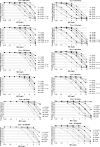Population Pharmacokinetic Study of Amoxicillin-Treated Burn Patients Hospitalized at a Swiss Tertiary-Care Center
- PMID: 29914948
- PMCID: PMC6125536
- DOI: 10.1128/AAC.00505-18
Population Pharmacokinetic Study of Amoxicillin-Treated Burn Patients Hospitalized at a Swiss Tertiary-Care Center
Abstract
The objective of this study was to investigate the population pharmacokinetics (PK) of amoxicillin in ICU burn patients and the optimal dosage regimens. This was a prospective study involving 21 consecutive burn patients receiving amoxicillin. PK data were analyzed using nonlinear mixed-effects modeling. Monte-Carlo simulations assessed the influence of various amoxicillin dosage regimens with identified covariates on the probability to achieve a target (PTA) value of time during which free amoxicillin concentrations in plasma exceeded the MIC (fT>MIC). A two-compartment model best described the data. Creatinine clearance (CLCR) and body weight (BW) influenced amoxicillin CL and central volume of distribution (V1), respectively. The median CLCR (Cockcroft-Gault formula) was high (128 ml/min), with 25% of patients having CLCRs of >150 ml/min. The CL, V1, and half-life (t1/2) values at steady state for a patient with a CLCR of 110 ml/min and BW of 70 kg were 13.6 liters/h, 9.7 liters, and 0.8 h, respectively. Simulations showed that a target fT>MIC of ≥50% was achieved (PTA > 90%) with standard amoxicillin dosage regimens (1 to 2 g every 6 to 8 h [q6-8h]) when the MIC was low (<1 mg/liter). However, increased dosages of up to 2 g/4 h were necessary in patients with augmented CLRs or higher MICs. Prolonging amoxicillin infusion from 30 min to 2 h had a favorable effect on target attainment. In conclusion, this population analysis shows an increased amoxicillin CL and substantial CL PK variability in burn patients compared to literature data with nonburn patients. Situations of augmented CLCR and/or high bacterial MIC target values may require dosage increases and longer infusion durations. (This study has been registered at ClinicalTrials.gov under identifier NCT01965340.).
Keywords: amoxicillin; burn patients; pharmacokinetics; population pharmacokinetics.
Copyright © 2018 American Society for Microbiology.
Figures




Similar articles
-
Population pharmacokinetic analysis of piperacillin in burn patients.Antimicrob Agents Chemother. 2014 Jul;58(7):3744-51. doi: 10.1128/AAC.02089-13. Epub 2014 Apr 21. Antimicrob Agents Chemother. 2014. PMID: 24752260 Free PMC article.
-
Population Pharmacokinetic Analysis of Doripenem after Intravenous Infusion in Korean Patients with Acute Infections.Antimicrob Agents Chemother. 2017 Apr 24;61(5):e02185-16. doi: 10.1128/AAC.02185-16. Print 2017 May. Antimicrob Agents Chemother. 2017. PMID: 28223378 Free PMC article.
-
Using Population Pharmacokinetic Modeling and Monte Carlo Simulations To Determine whether Standard Doses of Piperacillin in Piperacillin-Tazobactam Regimens Are Adequate for the Management of Febrile Neutropenia.Antimicrob Agents Chemother. 2017 Oct 24;61(11):e00311-17. doi: 10.1128/AAC.00311-17. Print 2017 Nov. Antimicrob Agents Chemother. 2017. PMID: 28807922 Free PMC article.
-
Intravenous Antibiotic and Antifungal Agent Pharmacokinetic-Pharmacodynamic Dosing in Adults with Severe Burn Injury.Clin Ther. 2016 Sep;38(9):2016-31. doi: 10.1016/j.clinthera.2016.08.001. Epub 2016 Aug 30. Clin Ther. 2016. PMID: 27586127 Review.
-
Population pharmacokinetics of imipenem in burn patients.Fundam Clin Pharmacol. 2003 Dec;17(6):645-50. doi: 10.1046/j.1472-8206.2003.00190.x. Fundam Clin Pharmacol. 2003. PMID: 15015709 Review.
Cited by
-
Risk Factors Associated with Antibiotic Exposure Variability in Critically Ill Patients: A Systematic Review.Antibiotics (Basel). 2024 Aug 24;13(9):801. doi: 10.3390/antibiotics13090801. Antibiotics (Basel). 2024. PMID: 39334976 Free PMC article. Review.
-
The effect of the acute phase of infection on absorption of and exposure to orally administered antibiotics in non-critically ill, hospitalized patients.J Antimicrob Chemother. 2023 Feb 1;78(2):389-396. doi: 10.1093/jac/dkac401. J Antimicrob Chemother. 2023. PMID: 36433818 Free PMC article.
-
Steering Away from Current Amoxicillin Dose Reductions in Hospitalized Patients with Impaired Kidney Function to Avoid Subtherapeutic Drug Exposure.Antibiotics (Basel). 2022 Sep 2;11(9):1190. doi: 10.3390/antibiotics11091190. Antibiotics (Basel). 2022. PMID: 36139969 Free PMC article.
-
Suitability of Amoxicillin-Clavulanic Acid for Administration via Prolonged Infusion.Drug Des Devel Ther. 2020 Jan 10;14:103-109. doi: 10.2147/DDDT.S230459. eCollection 2020. Drug Des Devel Ther. 2020. PMID: 32021095 Free PMC article.
-
The relation between inflammatory biomarkers and drug pharmacokinetics in the critically ill patients: a scoping review.Crit Care. 2024 Nov 19;28(1):376. doi: 10.1186/s13054-024-05150-4. Crit Care. 2024. PMID: 39563441 Free PMC article.
References
-
- Orban C, Tomescu D. 2013. The importance of early diagnosis of sepsis in severe burned patients: outcomes of 100 patients. Chirurgia (Bucur) 108:385–388. - PubMed
Publication types
MeSH terms
Substances
Associated data
LinkOut - more resources
Full Text Sources
Other Literature Sources
Medical

